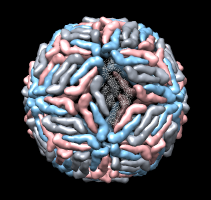

Tom Goddard
Science and Health Education Partnership
May 21, 2009
Computer Graphics Lab develops software to display and analyze 3-dimensional models of molecular machines such as viruses.
Look at some technology used to study the architecture of viruses.
Molecular machinery is unlike human designed objects (bicycles, cameras, ...) making it hard to figure out how it operates (assembles, performs chemical reactions, is disrupted by drugs or genetic mutations).
The foreign-ness of the machinery of life is not just because it operates on the molecular scale. Look at a human engineered molecular machine.

| 
|
| Human designed differential gear, disassembled. | Partial robot design for placing individual atoms. |
Show differential gear in Chimera. Spheres. Colored by element. Element coloring: gray carbon, red oxygen, blue nitrogen, white hydrogen, orange phosphorus, yellow sulfur. Non-biological: pink silicon, green fluorine. Rotation of two axles is coupled -- rotate in opposite directions. Car has differential to allow rear wheels to rotate at different rates.
Use LCD glasses. Show view down axis. Zoom in.
Cut in half (drag select, hide atoms). Move axle away using Move Selection Mouse mode. Select one axle atom and use Sc (select connected). Move conical gear away. Note "teeth" on axle and cone gears, and conical pivot.
Gear design comes from the Institute for Molecular Manufacturing. It is a fantasy -- has never been made and we have no technology that can make it. Eric Drexler envisioned making such machines with a universal machine that can place individual atoms. Show model of part of such a machine (fineMotion.pdb). Also not possible to make. These designs likely would not function as anticipated. Biological machines remarkably self-assemble instead of requiring external hands to assemble them.
Show 6-degree-of-freedom space navigator input device for rotating and translating models. Let everyone try it. (Can I get USB extension cord?) Useful to have natural object motion in combination with 3-d vision.
Many familiar viruses are pleomorphic -- each copy of the virus has a somewhat different shape.

|

|

|
|
Influenza virus. | HIV virus. | Ebola virus. |
We have the most detailed structural models for icosahedral viruses These show litle variation in shape. That allows imaging thousands to trillions of individual viruses combining data to see atomic resolution.

| 
| 
| 
|
| Rhino virus | Atoms of rhino virus | Hepatitis B virus | Polio virus |

| 
| 
| 
|
| Dengue virus | West Nile virus | Icosahedron superimposed on west nile virus | Satellite tobacco mosaic virus |
Each colored surface represents a protein. Different proteins have different colors. Examples shown have 1, 3, or 4 different proteins. All have icosahedral shape. Superimposing a geometric icosahedron shows each of the 20 triangular facets contains an identical arrangement of proteins. Different viruses are not shown to scale. Scale images.
Virus protein shell (capsid) is filled with viral RNA or DNA that encodes the viral proteins. Above models are hollow because imaging data for the RNA is a blur. For STMV half the ~1000 bases of RNA are observed and the positions of the rest can be guessed. Viewing the protein and RNA backbones as ribbons shows the virus is architecturally a big mass of precisely folded string.

| 
| 
|
| STMV all atoms | STMV ribbons | RNA ribbon |
Models above were derived from density maps which give the density at each point in the virus. The boundaries of the molecules are very hard to distinguish.

| 
| 
|
| Virus density map. | RNA density. | RNA density and ribbon. |
Use Phantom force-feedback input device to place markers tracing out RNA path in the density. Use 8A density map containing just RNA. Device provides a 3-d cursor and forces hold it in the highest density. Pressing stylus button drops marker. Pressing space allows moving density, "d" deletes selected marker, "z" allows zooming by twisting stylus, "c" adjust contour level using twist. Have all participants try.

LCD stereo glasses are expensive ($100 - $300), won't work with flat panel monitor, require high-end graphics card. Red-cyan glasses are a cheap alternative with no special requirements. Gray background reduces eye strain for me. Drawback is that glasses don't work well especially when red or cyan colors are used. Only gray-scale coloring works well.

Each participant has a different virus image, rna tape, capsid protein image, red/cyan glasses. Share tape. Name of virus is on virus, tape and protein. Can easily make a virus model from paper with proteins printed on the surface. Gives good feel for the icosahedral shape. The complexity of packing of the RNA can be appreciated using a paper ribbon for the RNA place in the paper shell. Provided RNA ribbon has exact base sequence shown with color bands A (adenine) = red, C (cytosine) = yellow , G (guanine) = green, U (uracil) = blue. Lengths range from 3000 to 8000 bases depending on virus. Viruses chosen for short genome length. Human DNA in one cell is ~1 million times larger and would pack entire projection room (5 x 5 x 10 m) at printed scale. Black beetle virus has two RNA strands. Images for cutting, folding, taping are online. Demonstrate folding along all triangle edges. Demonstrate taping edge. Clear tape. First apply tape to one edge using half width of tape, then push joining triangle edge onto other half of tape strip. Leave one triangle untaped for inserting RNA (random, spooled, ...).
| Dengue virus 1k4r | flattened (larger version suitable for printing) |
folded paper model |
 |
 |
 |
Chimera is free, download from web, Windows, Mac, Linux. Virus coordinate files are available from the Virus Particle Explorer (VIPERdb) web site and also from the Protein Data Bank (PDB). Density maps are available from VIPERdb and the EM Databank (EMDB). Images for paper virus models are on our web site.